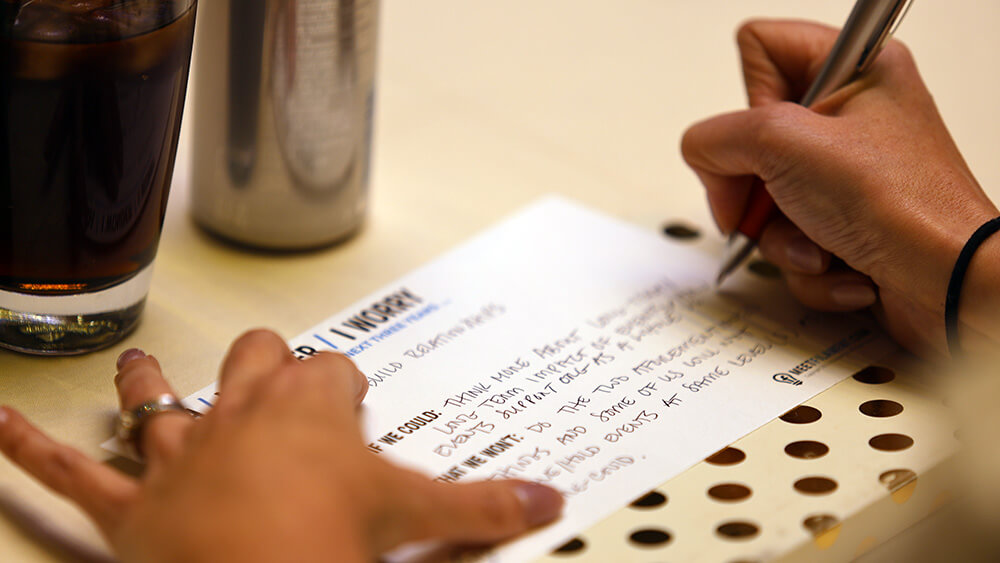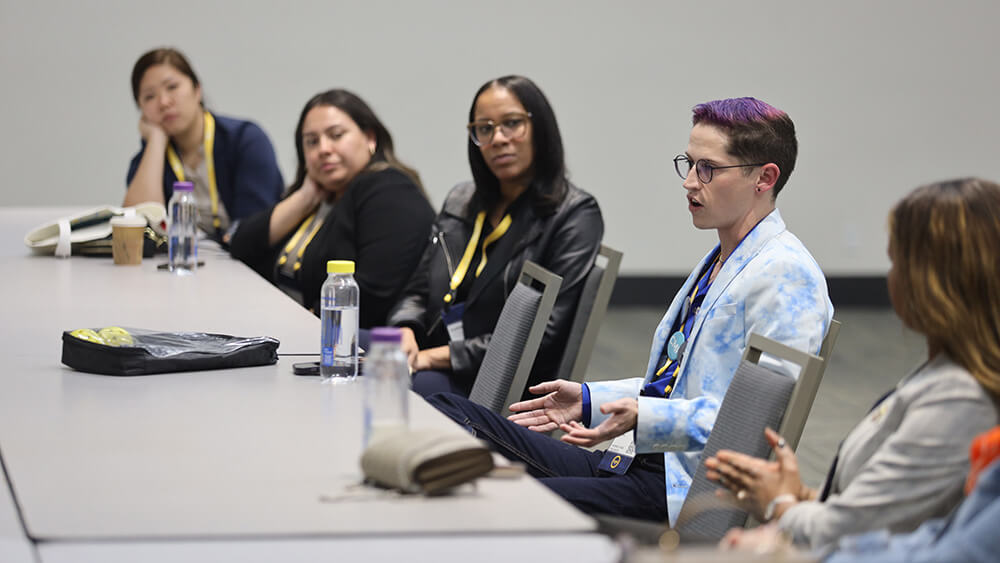
A participant of the executive leadership summit at Convening Leaders 2024 answers questions for a group exercise. The summit, which took place the day before CL officially started, is an example of two of Kimberly Hardcastle-Geddes’ 20 bright ideas to personalize events — pre-event and executive programming. (Whatever Media Group)
The term personalization is used so often in the events industry that its meaning has become a little hazy — does it refer to technology? Marketing? In-person experiences? Yes to all of the above, according to Kimberly Hardcastle-Geddes, CEM, president of the marketing and public relations firm, mdg, who offered 20 real-world examples of personalization in her presentation, “Facilitating Curated Event Experiences: How Thinking Small Delivers Big Returns,” at Convening Leaders 2024.
Personalization isn’t just confined to marketing or operations — it should be both, Hardcastle-Geddes said, and should include education, registration, and all the other touchpoints along your participants’ journey. Even if you have tried something before, “execution is where the magic happens” — or where an initiative could fail, she said. So, “monitor results, evaluate feedback, and then refine.”
And if you think something is a great idea, don’t give up too soon, Hardcastle-Geddes said. Many years ago, her company instituted a sustainability program for the National Bakery Association, which, she said, “went okay, but we didn’t have near the level of participation that we had hoped. We decided to give it another year and the participation grew exponentially. So, it needed a little bit of time to take off.”
Here are the 20 ideas Hardcastle-Geddes outlined in her presentation, many based on mdg’s work with clients, along with a condensed version of her remarks:
1. Offer docent-led exhibit hall tours. At large trade shows, like the Consumer Electronics Show (CES) in Las Vegas, tours are a way to give participants a personalized take on the highlights of the show. They can be done in a variety of ways — to point out the most innovative products, to introduce the show in additional languages for international attendees, to orient first-time attendees, etc. Recommended: Keep the tour group small so you can navigate easily through the trade-show floor and so that people can hear. And have somebody from outside the organization, such as an industry consultant, lead them.
2. Segment your trade show. This isn’t a revolutionary idea, but if you’ve been getting feedback that your trade show is too big and hard to navigate, the results of parsing it into categories can be revolutionary. That was the case for the National Association of Broadcasters, who saw “hugely positive” results when they reorganized their trade show by job function. It’s particularly helpful to people who attend your show with one particular purpose in mind.
3. Create themed lounges. An innovation first spotted many years ago, these are spaces where exhibitors and other attendees can come and be among their peers. Lounges also can include dedicated areas for panel discussions and other gatherings.
4. Offer private meeting rooms at your show. Supplier attendees often say that having private space where they can meet clients is crucial to their event attendance. And if your strategy to increase attendance is to encourage organizations to bring vertical buying teams to the show, those spaces also will enable internal teams to meet privately on site.

The Swinging Friar — the San Diego Padres mascot — greeted participants at Convening Leaders 2024 in the San Diego Convention Center. (Whatever Media Group)
5. Use show greeters. At the National Bakery Association’s International Baking Industry Exposition (IBIE) — which begins with a “bread-cutting” rather than a ribbon-cutting ceremony — the expo’s committee members, identifiable by their yellow shirts, are on the trade-show floor to thank everyone for coming, give directions, and answer questions. It’s a nice way to make the show feel more human.
6. Humanize your brand. Similarly, International Sign Association (ISA) President and CEO Lori Anderson, dressed in the color scheme for each year’s ISA Sign Expo, walks the floor, giving high fives and thanking people for coming to the show.
7. Organize pre-event meetings. Ask yourself how you can extend your event on the front or back end to meet the needs of smaller or niche groups who also may come to your larger event. One example is leadership training sessions, which can pave the way for smaller, tightly connected groups to form.
8. Offer executive programming. Attract senior level, C-suite attendees by creating content specifically for them. Recommended: Work with a consultant or other industry advisor who is really plugged into the needs of executives in your space — and vet attendance.
9. Offer young professionals programming. The research shows that young professionals like networking opportunities that are strategic, structured, and purposeful. Recommended: Do your own research and find out what younger professionals in your space are looking for. Build in some white space and ensure that you are making it possible for them to easily curate and customize their experiences in advance.
10. Have a welcoming registration area. This is often where attendees have their first encounter with your brand — so make sure registration areas are welcoming and engaging by playing music, offering drinks, and/or arranging for greeters from the organization to meet people as they arrive. You could offer Chapstick and Band-Aids and water, so attendees feel tended to during their first moments at the event.

Conversation Starters — small-group sessions where participants talk about specific topics and learn from one another — are now staples at PCMA events. (Whatever Media Group)
11. Hold peer-group discussions. Facilitated peer-to-peer group conversations — that zero in on problems and solutions or bring small and specific groups of people together, often around a table, to learn from one another — are easy to execute and can be extremely effective. Recommended: Have a facilitator at each table to keep the conversation flowing and on topic. Group people around specific topics, not characteristics such as “everybody from Montana” to make sure there is enough structure around the conversation.
12. Organize “no host” dinners. This is another one of those ideas that can be executed in a variety of ways for any number of reasons, but it offers an alternative for attendees who may otherwise end up ordering room service in their hotel rooms. One winning strategy: Organizers can set dinners up around town and stop by and say hello, but otherwise allow attendees to network on their own.
13. Offer a manicure bar. When a client offered this at an event, it was so popular it created problems — there were long lines of people waiting to get a polish instead of being in a session or on the trade-show floor. In subsequent years, attendees had to make an appointment in the app. The manicure bar was sponsored and gave sponsors an opportunity to strike up a conversation with participants as they got their nails done.
14. Provide mentorship. Pair new-to-the-workforce professionals or those who’ve never attended your event before with seasoned professionals who will meet with them, answer questions, and help them navigate the event. Recommendation: It should be very specific to the event, as opposed to being part of a larger mentorship program.
15. Organize a hackathon. Not in the strict sense of the word, but an experience that yields the same kind of focused engagement. Highlight a small or niche segment of your event, putting it center stage and creating entertainment from attendee participation — examples include a robotics challenge at an engineering-focused event, and cake-decorating competitions at a baking show.
16. Be a matchmaker. Understanding your audience personas and building pathways for them to connect to one another is a great way to make a large event feel smaller. AI has the potential to help facilitate these connections, but for now, blend technology with a human touch to make meaningful connections. Recommended: Look beyond purely transactional matchmaking efforts like matching attendees with exhibitors, and focus on intentionally facilitating meaningful connections.
17. Send VIP invitations. If you have identified C-level executives or VIP attendees as a priority, market to them differently than the way you are reaching out to everybody else. Executives have gatekeepers that are hard to get through, so phone calls don’t really work, and they are skeptical of promotional emails. What has worked is a hand-stuffed invitation sent via snail mail, with a message designed to appeal to their egos, like inviting them to lend their voices to a conversation with their peers.
18. Target registration communications. Sometimes it makes sense to send personalized invitations to those groups identified as a priority. For example, the National Restaurant Association Show developed a direct-mail invitation to its Chicago-based annual show, which was hand-delivered with a cake to Chicago-area restaurants, because they were within commuting distance and could potentially send multiple people to the event. One of the unexpected benefits was the number of people who posted about it on social media, which extended the campaign’s reach.
19. Personalize surveys. Use logic-based branching to customize follow-up survey questions based on how a respondent answers initial questions, such as their primary job responsibility. That allows you to collect data about the quality of sessions, exhibitors, etc., that is very specific to attendees.
20. Combine data for personalization. Aim to have systems in place that allow you to combine data — registration, behavioral, and marketing — to get a clear picture of who is coming to your event. It is easier said than done, but you can take small steps toward the goal. One client created a “master’s certificate program,” where if attendees took four courses in any targeted track, they could earn a certificate. Attendees got a message upon registration, updating them on how many courses they needed to complete the certificate and promoting those sessions.
Barbara Palmer is deputy editor of Convene.
